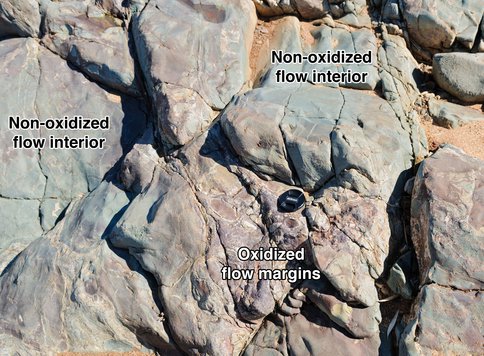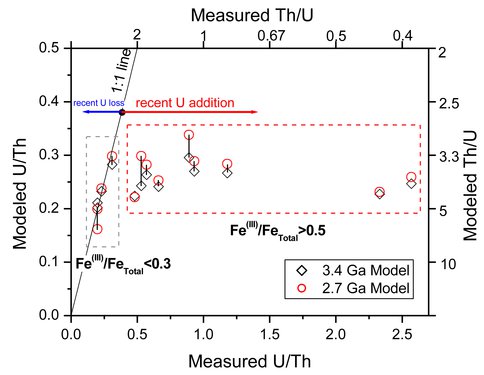2011 Annual Science Report
 University of Wisconsin
Reporting | SEP 2010 – AUG 2011
University of Wisconsin
Reporting | SEP 2010 – AUG 2011
Project 1C: U-Th-Pb Geochronology of the 3.4 Ga Apex Basalt Suggests an Anoxic Early Earth Atmosphere
Project Summary
Direct determination of the age of oxidative weathering in ancient rocks is difficult, but bears on when the surface environments of the Earth contained free oxygen, which in turn constrain when oxygenic photosynthesis was sufficient to overwelm reduced sinks for oxygen. It has been proposed that oxidized zones of the 3.4 Ga Apex Basalt in the Pilbara Craton formed in the Archean, at least 2.8 b.y. ago, and possibly as old at 3.4 b.y. ago. However, application of U-Th-Pb geochronology to these rocks indicate that oxidation was recent, probably within the last 200 m.y., reflecting deep Phanerozoic weathering that occurred across Australia. The oxidized zones therefore do not reflect the presence of free oxygen in the Archean.
Project Progress
Development of free oxygen in the atmosphere marked a major milestone in Earth history, reflecting sufficiently robust oxygenic photosynthesis such that reduced igneous gas and rock sinks were overcome, allowing free oxygen to exist in the surface environments of the Earth. Although most workers accept an age of ~2.4 to 2.3 Ga for the first significant rise of free oxygen in the atmosphere (e.g., Canfield 2005), some workers have argued that free oxygen existed at 3.4 Ga based on oxidation of basaltic lavas of that age in the Pilbara Craton, Australia. The Archean Biosphere Drilling Project (ABDP) was developed to collect samples below weathering profiles to avoid post-Archean weathering that may have affected near-surface samples, and Apex Basalt samples from depths greater than 100 m led Hoashi et al. (2009) and Kato et al. (2009) to propose that oxidation occurred prior to 2.8 Ga, and possibly as early as 3.4 Ga, which they interpret to reflect the presence of free-oxygen in the oceans and hence the atmosphere.
We analyzed basaltic samples from ABDP-1 drill core that have been variably oxidized (Fe(III)/FeTot = 0.12-1.00), using U-Th-Pb isotope geochronology to constrain the oxidation age of Apex Basalt. The appearance and range of oxidation of the core samples of Apex Basalt look similar to those of field exposures, where the interior of lava flows are not oxidized (Figure 1), but oxidation of flow rims has been interpreted by Hoashi et al. (2009) to record oxidation by oxygenated seawater in the Archean. Samples of the Apex Basalt from the ABDP-1 drill core at Marble Bar have high Pb and U concentrations, but non-radiogenic Pb isotope compositions. The samples do not form isochrons on ratios < 0.3 have negligible U addition (Figure 2). Such correlation implies coupling of the U addition and oxidation in the basaltic rocks. Because 235U and 238U decays to radiogenic 207Pb and 206Pb over time, the high U content and non-radiogenic Pb isotope composition of Apex Basalt mandate that the event of U addition for oxidized Apex Basalts cannot be old, and detailed modeling indicates that U enrichment most likely occurred in the last 200 Ma. This is consistent with the age range for deep weathering of the Pilbara Craton.
Our study suggests that the hematite-bearing Apex Basalt samples in ABDP-1 were oxidized by recent weathering processes, therefore hematite in Apex Basalt from Marble Bar cannot be used to infer an oxygenated atmosphere in the Archean. The fact that oxidation has reached great depth (>200m) implies deep drilling should not be regarded as a panacea for avoiding post-Archean oxidation in studies applying mineralogy to constrain Archean atmospheric oxygen level. The fact that hematite occurrence in Apex Basalt is controlled by shear zone (Kato et al. 2009) suggests that O2-bearing Phanerozoic meteoric may have utilized weak structures (shear zone, fracture, faults) to facilitate oxidation at depth greater than usual weathering profile.
Canfield DE (2005) The early history of atmospheric oxygen: Homage to Robert M. Garrels. Annual Review of Earth and Planetary Sciences 33(1):1-36
Hoashi M, Bevacqua DC, Otake T, Watanabe Y, Hickman AH, Utsunomiya S, Ohmoto H (2009) Primary haematite formation in an oxygenated sea 3.46 billion years ago. Nature Geosci 2(4):301-306
Kato Y, Suzuki K, Nakamura K, Hickman AH, Nedachi M, Kusakabe M, Bevacqua DC, Ohmoto H (2009) Hematite formation by oxygenated groundwater more than 2.76 billion years ago. Earth and Planetary Science Letters 278(1-2):40-49
Figure 1. 3.4 Ga Apex Basalt, Pilbara Craton, Australia. The fractured flow margins of the lavas flows have been oxidized (pink color), whereas the interiors of individual flows have not been oxidized (green color). Some workers have interpreted the oxidation to reflect interaction with oxygenated seawater at 3.4 Ga.
Figure 2. Plot of measured U/Th ratio of the basalt samples versus modeled U/Th ratio that is calculated from the samples Pb isotope composition. The “3.4 Ga Model” assumes the system remained closed to U addition since 3.4 Ga; the “2.7 Ga Model” assumes that the system remained closed since 2.7 Ga. Different models yield similar results, indicating recent U addition must have occurred for samples with Fe(III)/FeTot>0.5 but un-oxidized samples are not disturbed by U addition.
Publications
- Li, W., Beard, B. & Johnson, C. (2012, In Press). U-Th-Pb isotope data indicate Phanerozoic age for oxidation of 3.4 Ga basalts from Marble Bar, Pilbara Craton, NW Australia. Earth and Planetary Sciences Letters,.
- Li, W., Johnson, C. & Beard, B. (20111). U-Th-Pb isotopic constraints on the oxidation age of 3.4 Ga basalts from Marble Bar, Pilbara Craton, NW Australia. AGU Fall Meeting.
-
PROJECT INVESTIGATORS:
-
PROJECT MEMBERS:
Brian Beard
Co-Investigator
Weiqiang Li
Postdoc
-
RELATED OBJECTIVES:
Objective 4.1
Earth's early biosphere.
Objective 7.1
Biosignatures to be sought in Solar System materials


